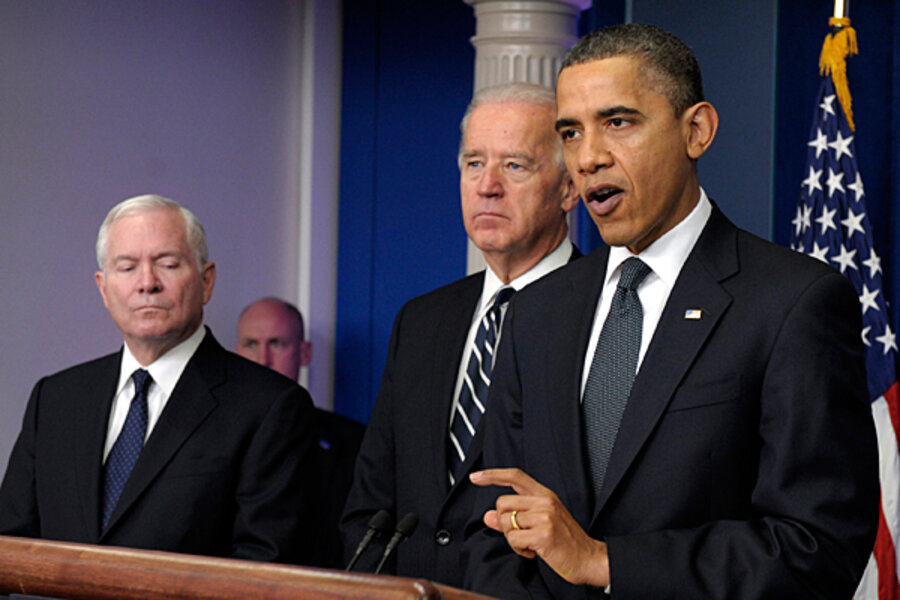Decoding Obama's comments on war in Afghanistan: What did he really mean?
Loading...
| Washington
A year after announcing 30,000 additional troops for the US-led fight in Afghanistan, President Obama offered a mixed picture of “fragile” progress and of more difficult days ahead in his annual review of the war.
Yet compared with a year ago – when Mr. Obama set the stage for the beginning of a troop withdrawal in summer 2011 – the president’s message on Thursday was more focused on the conditions that will determine the pace of a drawdown over the next four years.
The shift in message is in part designed to tell the central actors in the war – the Taliban, the governments in Afghanistan and Pakistan, as well as the Afghan population – that the US and its partners are not pulling out any time soon, some policy analysts say. The review also reflects the commitment the US and NATO members made earlier this month to a transfer of combat responsibilities to Afghan security forces by December of 2014.
IN PICTURES: Winning hearts and minds in Afghanistan
Moving the goal posts
“The administration has rather subtly moved the goal posts from 2011 to 2014, something it began doing about six months ago,” says James Dobbins, a longtime US diplomat and Afghanistan expert now at the Rand Corp. in Arlington, Va. While 2011 had “some utility, particularly in domestic politics,” Ambassador Dobbins adds that the administration quickly realized the date also had some costs.
“It fed the impression in the region that the US could simply be waited out,” he says, “and that our support of the government in Afghanistan had a time limit on it.”
The message of “fragile but reversible progress” also signals to Americans less supportive of the war than ever that the next six months will be critical to determining the magnitude – or mere symbolism – of the drawdown to begin in July 2011.
The early months of the year, when the Taliban’s traditionally return to offensive mode, will offer a hint of how “fragile” the security progress is, military experts say, and thus of what kind of drawdown the US can safely begin in July.
Message to Pakistan
Aside from the Afghan security conditions, the review’s assessment of “fragile but reversible” progress also applies to the engagement of the Pakistani government in tackling of safe havens from which fighters in Afghanistan operate.
Obama referred to “regional cooperation” – referring primarily to Pakistan – as one of the key pillars of the administration’s Afghanistan strategy.
The president said the US has communicated a strong message to Pakistan that “the safe havens must be dealt with.” But privately, US intelligent officials are more categorical: Additional progress in Afghanistan will be almost impossible unless Pakistan does more, and soon, about the insurgents that cross from Pakistan into Afghanistan.
“Pakistan, as always, remains the hardest part of this problem,” says Bruce Riedel, a senior fellow at the Brookings Institution in Washington and a former CIA South Asia specialist who co-chaired Obama’s first Afghanistan-Pakistan review.
Mr. Riedel says the new strategic dialogue the US has established with Pakistan is a step in the right direction. But he adds that the “jihadist Frankenstein” that Pakistani officials helped create for their own purposes will not be easily shut down.
Obama was his most positive in describing what he called the “significant progress” that has been made in the “core” American goal of “disrupting, dismantling, and defeating Al Qaeda in Afghanistan and Pakistan.” Compared with nine years ago, when the senior Al Qaeda leadership fled Afghanistan, Obama said the senior leaders are “hunkered down” and are finding it harder to recruit, to travel, to train, and to “plot and launch attacks.”
Riedel says the Al Qaeda leadership has felt significant impact from US drone attacks, and he offers the example of Osama bin Laden’s top assistant, Ayman al-Zawahiri. Noting that the number of anti-American “diatribes” issued by the Al Qaeda message man has dropped from one every other week to four so far this year, Riedel says, “His operational tempo has been disrupted.”
But by defining the war as at its “core” a battle with Al Qaeda, Obama is also relegating to secondary status the counterinsurgency goal of winning Afghan “hearts and minds” through better protection of civilians and improved delivery of basic services.
Whither nation-building?
In his White House statement, Obama underscored the core goal in Afghanistan – defeating Al Qaeda – by defining what it is not. “It’s not nation-building, because it is Afghans who must build their nation.”
Just a few minutes later, however, speaking from the same podium about the same review, Secretary of State Hillary Rodham Clinton emphasized the civilian component of the international effort in Afghanistan. Noting that the US alone has more than 1,000 civilian diplomats and specialists in Afghanistan, Secretary Clinton said that the “rebuilding of Afghanistan is an international commitment.”
So which is it? Dobbins says nation-building may have a bad name – thus Obama’s rejection of it – but he adds that the US will never be able to safely depart unless Afghans are able to run their country themselves.
“As a practical matter, we have to build indigenous capacity if we don’t want to stay there forever,” Dobbins says. “Call that work whatever you want … but a rose is a rose.”





